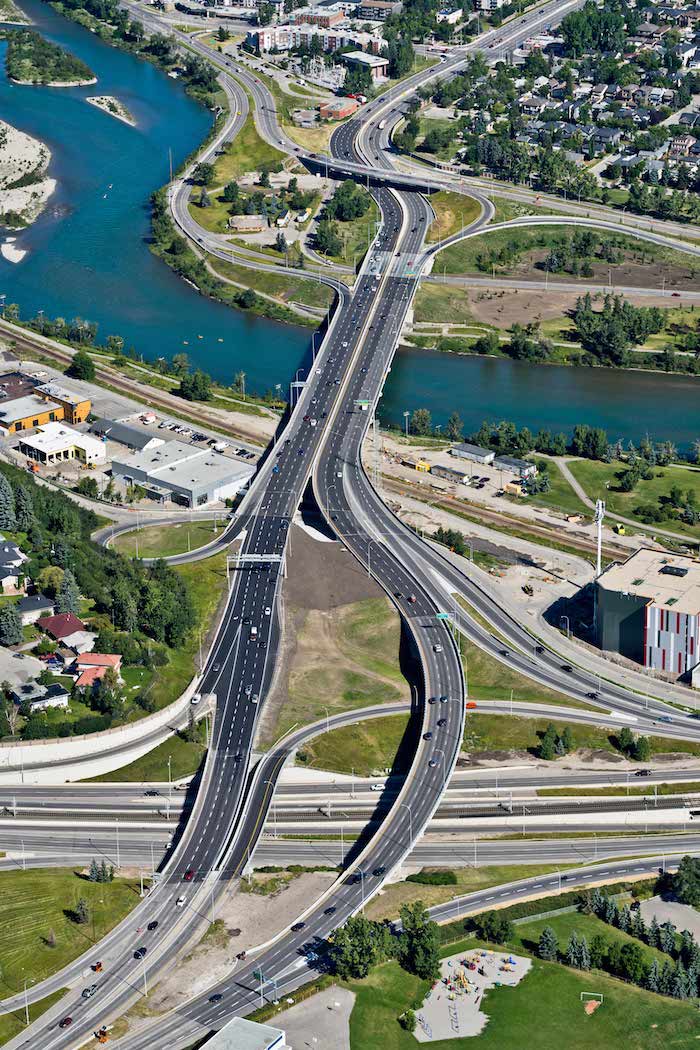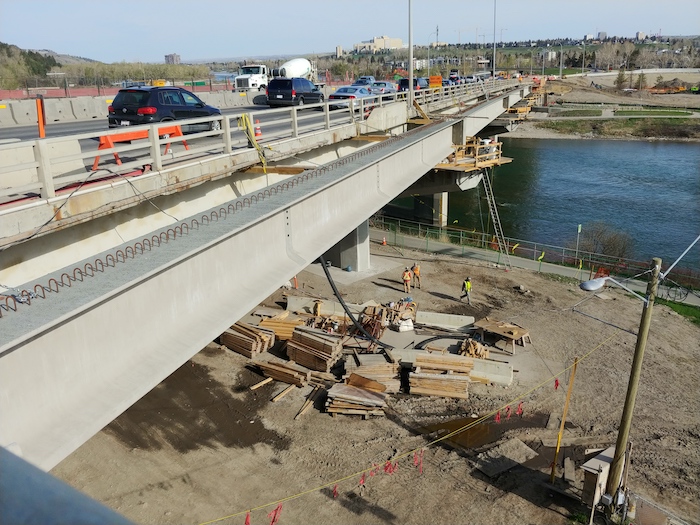
2022 #CCEawards Showcase: Crowchild Trail Bow River Bridge Widening and Rehabilitation
November 9, 2022
By CCE
“The consultants showed resourcefulness in delivering a very cost-effective project.” – Jury
Category: Transportation
Award of Excellence Winner: Associated Engineering
Associated Engineering’s (AE’s) design for rehabilitating and widening Calgary’s Crowchild Trail Bow River Bridge enhances the functionality, safety and useful life of the structure. The cost-effective, sustainable project reused the existing structure, reducing demolition, limiting waste and protecting the river, while a complex traffic staging plan mitigated interruption to commuters, railways and businesses.
An alternative strategy
Crowchild Trail is Calgary’s busiest transportation corridor, connecting people, goods and services from Glenmore Trail to 16th Avenue. The bridge, one of a few to cross the Bow River, was constructed in 1968. After 50 years of service, it was severely deteriorated. The municipal government considered numerous options for replacement, some projected at more than $1 billion and requiring the expropriation of several blocks of homes.
Instead, the city engaged AE to rehabilitate the bridge based on the firm’s concept, which envisioned a wider, safer bridge by adding a full traffic lane in each direction. This strategy, which included ramp reconfigurations, would restore the structural integrity of the substructure, increase capacity and improve the functionality of the interchange.
Further, AE suggested construction could be completed without interrupting traffic service or the nearby Canadian Pacific (CP) Railway tracks, eliminating the need for a temporary structure and additional investment over the two-year construction period.
To accommodate the increase in rolling surface and an extra girder-line on each side of the bridge, the project team explored ways to expand the deck, strengthen the piers and modify the load path transfer to the existing piers and abutments, in an effort to rearticulate the entire structure. They recommended tying piers together horizontally using an innovative encapsulation approach, which redistributes load using existing infrastructure, thus avoiding demolition of the existing bridge.
The river piers were supported by a spread footing on bedrock. The foundations were in good condition, sufficient to sustain added weight. The pier caps, however, needed to be longer, wider and deeper to accommodate the additional girder-lines.
To accomplish this, the pier caps were tied in using reinforced concrete. The original pier caps were encapsulated into the new widened pier caps. This provided enough strength and horizontal stability to accommodate interface shear. The load from the pier caps is redistributed vertically down the pier shaft before arriving on the foundations.
South of the river, two piers were piled into bedrock and four were founded on spread footings. All of the land-based piers were encapsulated from the pile foundation to the underside of the deck at the pier caps. The spread footing was dug out and piles were added before encapsulating the foundation. Pile caps were also encapsulated. The encapsulated shell provides sufficient strength to support the full load of the widened structure.
AE designed safety improvements for all modes of transportation, including new lighting for pedestrians, increased shoulder widths a new median and side single-slope barriers. Intermediate diaphragms were extended and are now architectural features.
The interchange’s reconfiguration reduces traffic weaving, increases merging distance, improves safety and reduces the risk of accidents. The 50-year-old deck cantilevers and traffic barriers were replaced and both median and side barriers were upgraded.
The project has extended the bridge’s service life for another 30-plus years, accommodating current and future forecast population and traffic demand. At $27.5 million, the project saved hundreds of millions of dollars compared to the initial replacement options.
Reconfiguration without interruption
The bridge widening enabled the realignment of the intersection of 10th Avenue and Bow Trail and the relocation of the Memorial Drive exit ramps. ‘Untangling’ the existing ramps and lengthening the weave distance substantially improved safety. The original infrastructure included unfavourable merge lanes and ramps that created gridlock and increased risk of collisions.
With the extent of structural deterioration unknown, AE involved the contractor early, at the 70% stage of detailed design. The team developed a construction sequence that would maintain structural integrity and reasonable productivity to ensure timely project completion.
The bridge’s rehabilitation and widening were complicated by six power transmission ducts built into its deck. The high-voltage lines inside these ducts provided a large portion of southwest Calgary’s power supply. Working with the utility, Enmax, AE designed and built a new duct alignment into the widened section of bridge deck. To allow for bearing replacement, AE developed a bridge jacking strategy that accommodated traffic loads and allowable stresses in the ducts due to deflection.
Construction sequencing was planned down to the hour. Services to nearby amenities and businesses remained uninterrupted, heavy traffic was safely accommodated with 3.3-m wide lanes and the number of available lanes was never reduced during construction.
Environmental advantages
Leveraging and reusing existing infrastructure offered significant environmental advantages, given the size and scale of this project.
Instead of building in-stream berms, for example, the team redistributed the load to existing land piers and abutments, so work was not required on the foundations of the river piers. The tie-in on the river pier caps was completed from above, further reducing the impact on the river and aquatic life. These modifications provided enough additional loading capacity for the bridge, eliminating the need to modify the river piers.
Further, by relocating the Memorial Drive exit ramps, the new configuration created more usable greenspace and river pathways on the north side of the bridge and river, as well as improved connections to the city’s entire pathway system.
As Calgary’s population has more than doubled in the last 50 years, the bridge struggled to handle the increased traffic demand. This project marked the first combined widening and rehabilitation of any major in-service bridge in Alberta’s history. The cost-effective restoration has improved quality of life for commuters by establishing a more efficient transportation network, which will serve Calgary for generations to come.
Crowchild Trail Bow River Bridge Widening and Rehabilitation, Calgary
Award-winning firm (prime consultant): Associated Engineering, Calgary (Jim Zagas, RET, P.L. (Eng.); David Nagy, P.Eng.; Jonathan Wiens, P.Eng., PMP; Peter Grant, B.E. (Civil), PMP; Mitch Koepke, P.Eng.; David Harvey, M.Sc., P.Eng., Struc. Eng., FEC; Simon Cook, P.Eng.; Howard Chu, P.Eng.; Tijana Vulic, P.Eng.; Christel Lope, C.E.T.).
Owner: City of Calgary.
Other key players: Thurber Engineering (subconsultant), Graham Construction (contractor), ISL Engineering and Land Services, LaFarge (girders, concrete, asphalt) LCL-Bridge Products Technology (bridge bearings).

